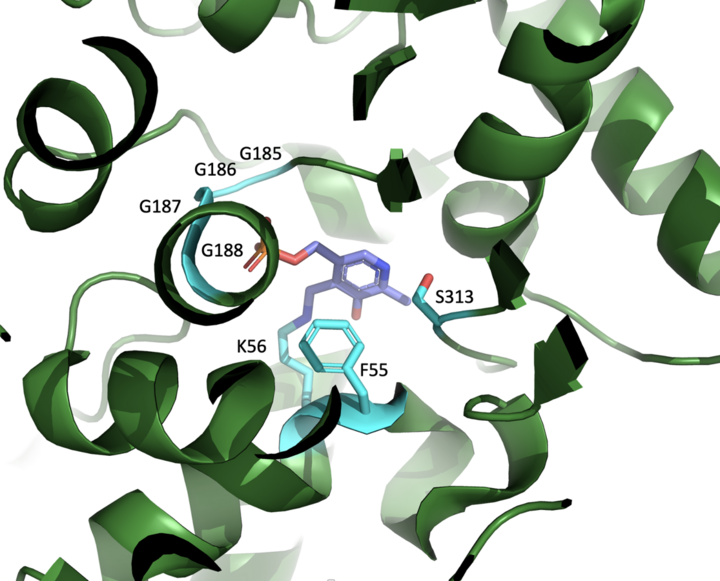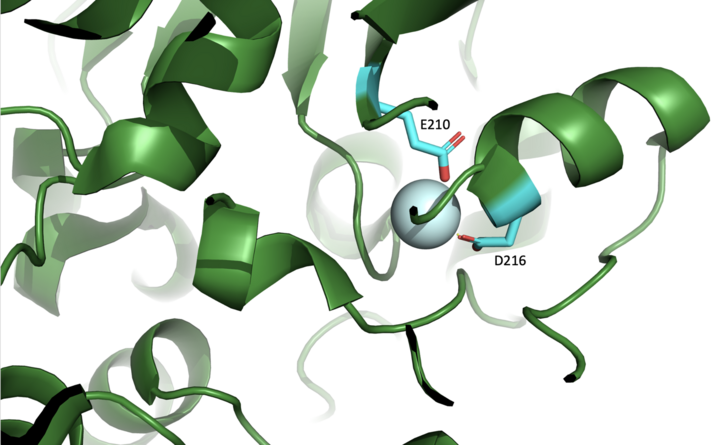Biology:Serine racemase
 Generic protein structure example |
Serine racemase (SR, EC 5.1.1.18) is the first racemase enzyme in human biology to be identified. This enzyme converts L-serine to its enantiomer form, D-serine. D-serine acts as a neuronal signaling molecule by activating NMDA receptors in the brain.
Since NMDA receptors Dysfunction has been suggested as one of the promising hypotheses for the pathophysiology of schizophrenia, it has been shown that underexpression of this enzyme is an indicator, especially for the paranoid subtype.[1] Treatment of schizophrenia with D-serine has been shown to play some role in ameliorating some symptoms.[2]
In humans, the serine racemase protein is encoded by the SRR gene.[3] Serine racemase may have evolved from L-thre-hydroxyaspartate (L-THA) eliminase and served as the precursor to aspartate racemase.[4]
Mammalian serine racemase is a pyridoxal 5'-phosphate dependent enzyme that catalyzes both the racemization of L-serine to D-serine and also the elimination of water from L-serine, generating pyruvate and ammonia through the β-elimination of L-serine.[5] This makes serine a known bifurcating enzyme. The β-elimination pathway is thought to serve as a bleed valve that allows local stores of L-serine to be diverted away from D-serine as a means of muting the D-serine signaling pathway. The canonical tetraglycine loop that serves as a PLP phosphate binding pocket includes the active residues being F55, K56, G185, G186, G187, G188, and S313.[4]
The enzyme is physiologically stimulated by divalent cations (e.g., magnesium) and is allosterically activated by the magnesium/ATP complex, associated with a conformational change upon nucleotide binding that depends upon interactions with Q89. The canonical coordination sphere of the divalent cation interaction site includes the active residues E210 and D216 within 2.1 angstroms of the ion.[4]
References
- ↑ Morita, Yukitaka; Ujike, Hiroshi; Tanaka, Yuji; Otani, Kyohei; Kishimoto, Makiko; Morio, Akiko; Kotaka, Tatsuya; Okahisa, Yuko et al. (May 2007). "A Genetic Variant of the Serine Racemase Gene Is Associated with Schizophrenia" (in en). Biological Psychiatry 61 (10): 1200–1203. doi:10.1016/j.biopsych.2006.07.025. PMID 17067558. https://linkinghub.elsevier.com/retrieve/pii/S000632230600936X.
- ↑ Fujii, K; Maeda, K; Hikida, T; Mustafa, A K; Balkissoon, R; Xia, J; Yamada, T; Ozeki, Y et al. (2006-02-01). "Serine racemase binds to PICK1: potential relevance to schizophrenia" (in en). Molecular Psychiatry 11 (2): 150–157. doi:10.1038/sj.mp.4001776. ISSN 1359-4184. PMID 16314870. https://www.nature.com/articles/4001776.
- ↑ "Human serine racemase: moleular cloning, genomic organization and functional analysis". Gene 256 (1–2): 183–8. Oct 2000. doi:10.1016/S0378-1119(00)00356-5. PMID 11054547.
- ↑ 4.0 4.1 4.2 Graham, Danielle L.; Beio, Matthew L.; Nelson, David L.; Berkowitz, David B. (2019-03-13). "Human Serine Racemase: Key Residues/Active Site Motifs and Their Relation to Enzyme Function". Frontiers in Molecular Biosciences 6: 8. doi:10.3389/fmolb.2019.00008. ISSN 2296-889X. PMID 30918891.
- ↑ "Cofactors of serine racemase that physiologically stimulate the synthesis of the N-methyl-D-aspartate (NMDA) receptor coagonist D-serine". Proceedings of the National Academy of Sciences of the United States of America 99 (22): 14542–7. Oct 2002. doi:10.1073/pnas.222421299. PMID 12393813. Bibcode: 2002PNAS...9914542D.
Further reading
- "A genetic variant of the serine racemase gene is associated with schizophrenia". Biological Psychiatry 61 (10): 1200–3. May 2007. doi:10.1016/j.biopsych.2006.07.025. PMID 17067558. http://ousar.lib.okayama-u.ac.jp/10930.
- "Serine racemase protein expression in cortex and hippocampus in schizophrenia". NeuroReport 17 (11): 1181–5. Jul 2006. doi:10.1097/01.wnr.0000230512.01339.72. PMID 16837850.
- "Serine racemase binds to PICK1: potential relevance to schizophrenia". Molecular Psychiatry 11 (2): 150–7. Feb 2006. doi:10.1038/sj.mp.4001776. PMID 16314870.
- "Modulation of D-serine levels via ubiquitin-dependent proteasomal degradation of serine racemase". The Journal of Biological Chemistry 281 (29): 20291–302. Jul 2006. doi:10.1074/jbc.M601971200. PMID 16714286.
- "Mouse brain serine racemase catalyzes specific elimination of L-serine to pyruvate". FEBS Letters 535 (1–3): 44–8. Jan 2003. doi:10.1016/s0014-5793(02)03855-3. PMID 12560076.
- "Recombinant human serine racemase: enzymologic characterization and comparison with its mouse ortholog". Protein Expression and Purification 63 (1): 62–7. Jan 2009. doi:10.1016/j.pep.2008.09.003. PMID 18812225.
- "Elevated PICK1 mRNA in schizophrenia increased SRR mRNA in suicide". Schizophrenia Research 120 (1–3): 236–7. Jul 2010. doi:10.1016/j.schres.2010.03.002. PMID 20385472.
- "Identification of multiple serine racemase (SRR) mRNA isoforms and genetic analyses of SRR and DAO in schizophrenia and D-serine levels". Biological Psychiatry 57 (12): 1493–503. Jun 2005. doi:10.1016/j.biopsych.2005.03.018. PMID 15953485.
- "Characterization and localization of a human serine racemase". Brain Research. Molecular Brain Research 125 (1–2): 96–104. Jun 2004. doi:10.1016/j.molbrainres.2004.03.007. PMID 15193426.
External links
- Serine+racemase at the US National Library of Medicine Medical Subject Headings (MeSH)
- Overview of all the structural information available in the PDB for UniProt: Q9GZT4 (Serine racemase) at the PDBe-KB.
 |



